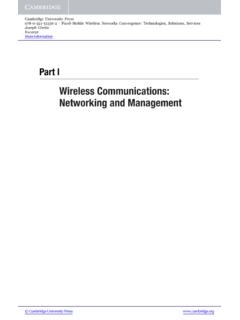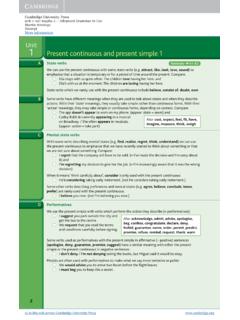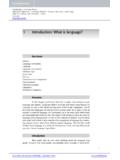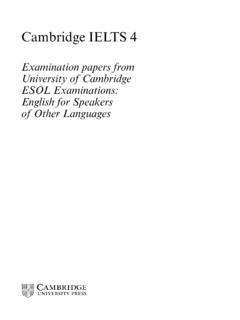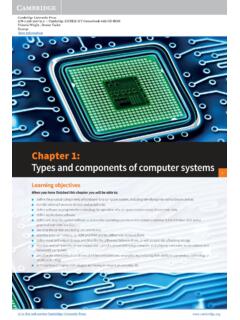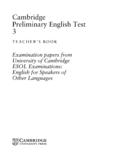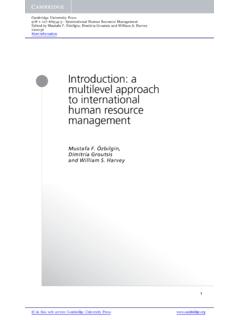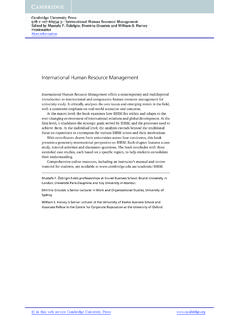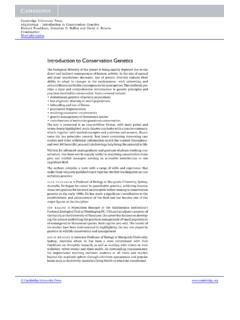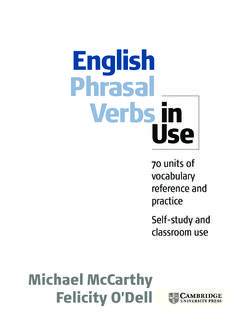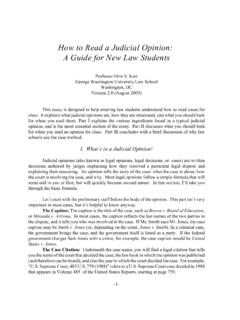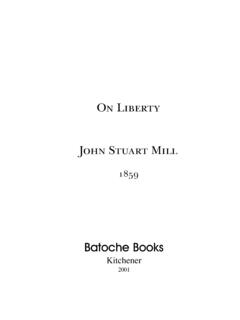Transcription of Writing an Expository Essay - Cambridge University Press
1 Cambridge University Press978-1-107-62109-1 Academic Writing Skills 2 Student s BookPeter Chin, Samuel Reid, Sean Wray, Yoko YamazakiExcerptMore information in this web service Cambridge University an Expository EssayPart 1 Essay structure and the introductory paragraphPart 2 Body paragraphs, concluding paragraphs, and outliningPart 3 Improving your workCambridge University Press978-1-107-62109-1 Academic Writing Skills 2 Student s BookPeter Chin, Samuel Reid, Sean Wray, Yoko YamazakiExcerptMore information in this web service Cambridge University structureSection 1An Essay is a piece of Writing made up of a number of paragraphs.
2 Each paragraph has a specifi c role in an Essay . In a fi ve-paragraph Essay , the fi rst paragraph is an introduction; the second, third, and fourth paragraphs form the body of the Essay ; and the fi fth paragraph is a conclusion (see diagram on page 4). This book will focus exclusively on the fi ve-paragraph Essay . Although essays may vary in length, the fi ve-paragraph Essay structure can be adapted for longer or shorter Introductory paragraphThe fi rst paragraph of an Essay should introduce the reader to the Essay topic.
3 It should create interest in the Essay , outline the writer s main ideas, and suggest how these ideas will be presented within the body of the Essay . The introduction consists of three main elements: a hook, building sentences, and a thesis Hook The fi rst sentence (or sentences) of an Essay should catch the reader s attention. It introduces the topic of the Essay in an interesting Building sentences After the hook, the following sentences should provide background information to give readers some context about the topic.
4 They should build towards the thesis statement. 3. Thesis statement The thesis statement comes at the end of the introduction. It is the most important sentence in the entire Essay because it presents the Essay topic and the writer s position on that topic. It also indicates the main ideas that will be discussed in the body structure and the introductory paragraph1 PartCambridge University Press978-1-107-62109-1 Academic Writing Skills 2 Student s BookPeter Chin, Samuel Reid, Sean Wray, Yoko YamazakiExcerptMore information in this web service Cambridge University 1 Part 12.
5 Body paragraphsThe body of an Essay consists of three paragraphs. Each body paragraph explains in detail one of the main ideas expressed in the thesis statement. There are three parts to a body paragraph: a topic sentence, supporting sentences, and a concluding Topic sentence The fi rst sentence of a body paragraph expresses the topic of the paragraph and provides a controlling idea about the topic. All information in the paragraph supports the controlling Supporting sentences Supporting sentences explain and develop the topic sentence.
6 They present logical thoughts, evidence, and explanations in support of the controlling Concluding sentence The paragraph may end with a concluding thought on the paragraph topic. It may also show a transition to the next Concluding paragraphThe concluding paragraph ends the Essay by reviewing the main ideas from each body paragraph and leaving the reader with a fi nal thought. The conclusion consists of three elements: a restated thesis, a summary of main ideas, and a fi nal Restated thesis At the start of the conclusion, the thesis is restated in words different from those in the Summary of main ideas The main ideas from each of the body paragraphs are summarized as a reminder to the Final thought The writer ends the Essay by presenting a fi nal thought on the topic for example, by stating an opinion , a solution, or a prediction.
7 The fi nal thought should leave a strong impression and encourage the reader to think further about the University Press978-1-107-62109-1 Academic Writing Skills 2 Student s BookPeter Chin, Samuel Reid, Sean Wray, Yoko YamazakiExcerptMore information in this web service Cambridge University Essay structureIntroductory paragraphHookBuilding sentencesThesis statementConcluding paragraphRestated thesisSummary of main ideasFinal thoughtBody paragraph 1 Topic sentenceSupporting sentencesConcluding sentenceBody paragraph 2 Topic sentenceSupporting sentencesConcluding sentenceBody paragraph 3 Topic sentenceSupporting sentencesConcluding sentenceCambridge University Press978-1-107-62109-1 Academic Writing Skills 2
8 Student s BookPeter Chin, Samuel Reid, Sean Wray, Yoko YamazakiExcerptMore information in this web service Cambridge University 1 Part 1 Exercise 1 The model Essay below answers the following Essay question: Explain how an alternate form of energy is being used successfully in the world today. Identify these elements in the following model Essay . 1. Introduction, body, and conclusion. 2.
9 The three main parts of the introduction. 3. The three main parts of each body paragraph. 4. The three main parts of the conclusion. I d put my money on the sun and solar energy. What a source of power! I hope we don t have to wait until oil and coal run out before we tackle that.
10 With this statement, Thomas Edison, the inventor of the light bulb, recognized the capacity of the sun as a virtually limitless source of energy in 1931. However, although a time when oil and coal have been completely used up could be getting closer, the full potential of solar power is yet to be harnessed by mankind. Televisions, refrigerators, air conditioners, and all the other appliances common in the developed world require vast amounts of electricity, meaning that the world s most powerful countries still very much depend on fossil fuels.
